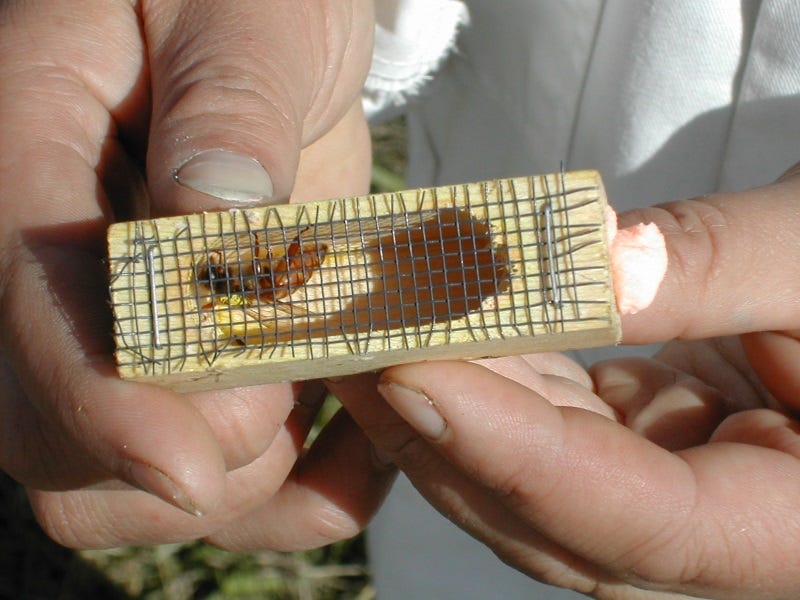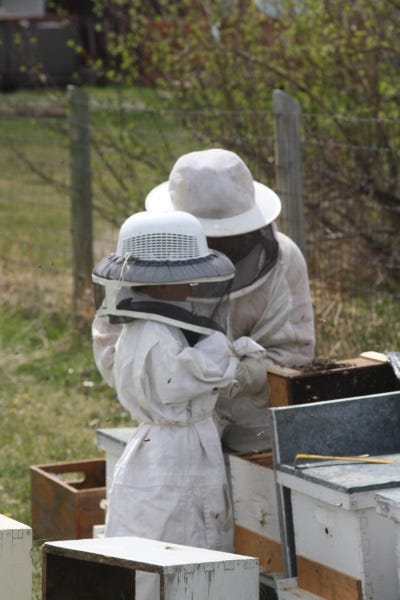Bee Health: Summer Time Heat and How to Help Them

“As the dog days of summer grind on it’s important to not forget about the health of your apiary.” -- By Amy Grisak
The honey harvest is fast approaching, and even though we might feel as if we’re celebrating the culmination of hard work throughout the season, the bees are beginning their new year.

Keep ‘em cool
Like most of us, honey bees need to stay cool when the mercury climbs above 90 degrees Fahrenheit. As a result, the dog days of summer can be tough on the colony. While most of us realize how winter temperatures impact hive health, it’s just as critical to moderate extreme heat events to keep the hive productive. Optimal brood rearing temperatures range between 91-97 degrees Fahrenheit. The bees expend a lot of effort, and significant resources, maintaining this level.
Fortunately, we can help. Providing some sort of shade, whether it’s from trees or a building, can greatly reduce heat stress on the hive. Since many hives are placed in wide-open areas, optimum for nectar producing plants (but short on sun protection), shade isn’t always near.
If you know anyone interested in taking up beekeeping, have them read this.
An easy step is to paint the metal top of the hive white potentially dropping the temperature inside the hive by 10 degrees. You can also create a type of double roof by making a ventilated gable for your colony, adding air space between the top of the roof and the hive body. This helps reduce the overall internal temperature. If you don’t want to go the craftsman route, raising the telescoping hive cover by four inches, using something as simple as corrugated plastic (like what’s used in sign material) directly underneath the metal cover may also reduce the direct heat load on top of the hive.
Ventilation is equally critical. If you have only one opening at the bottom of the colony, think of all the hot air trapped within the hive body. Many beekeepers find it beneficial to drill a ventilation hole at the top of each box. (You can also plug it later, if necessary.) Some beekeepers also place the screened bottom board used for Varroa control to allow more air circulation from the base. Additionally, ventilated covers made with screen material can replace the telescopic covers to keep air circulation at an optimal level.
Proper air circulation is equally important in regions with significant humidity levels. Moisture is the enemy of a healthy hive as it promotes diseases and fungal infections. While moisture build up is often most prevalent in cooler months, it can still impact your hive in the summer so be sure there is adequate airflow.
We've got an entire catalog of beekeeping supplies online here.
Watch for Swarming
While the traditional swarm season is early in the season, when brood numbers are growing exponentially, it can happen at any time during the summer season. When half the bees leave the hive late in the season, it doesn’t bode well for the evacuees, nor the bees that remain.
To nip a swarm before it happens, keep a close eye on the creation of queen cells, as well as noting laying patterns. If the queen is failing - or gone completely - you should re-queen. Not only does this provide more brood throughout winter—creating a more resilient hive that can withstand colder temperatures—a mature queen coming out of the winter can bring the hive to optimum numbers earlier in the season.

Protect them from Predators
We all know the latter part of the summer is the time to harvest honey, and some of the wildlife is just as cued in on the process. Bears oftentimes raid apiaries in an attempt to acquire those all-important calories. Whether you have black bears or grizzlies in the area, they can be persuaded to leave the hives alone by a properly constructed electric fence.
Skunks and raccoons find honey and larvae, as well as the bees themselves, an irresistible snack that is yummy and nutritious. Skunks sometimes simply snack upon the bees as they exit the hive to protect it, while raccoons, with their dexterous little paws, can sometimes reach within the hive body or lift off boxes to scoop out their golden prize.
Both critters are smart. If you don’t have a mesh electric fence around your hives, a more primitive option is to set out the “welcome mats,” which are boards spiked with nails set so the sharp end will dissuade sensitive paws. (Backcountry cabins often use similar, yet much larger, versions to discourage bears from breaking into doors and windows.) Place them around the hive to create a pointy barrier, and be sure to tack them down to the ground because both skunks and raccoons are smart enough to flip them over.
Mite Mitigation
“Making sure your bees are healthy going into the winter” means making sure they aren’t battling Varroa mites in the fall. Mite control takes place after the honey is removed since nobody wants a miticide, even a natural one, tainting their honey. Check mite levels using either the sticky trap method in the bottom board, or by giving them the sugar test method. Many beekeepers treat the mites if they find 10 or so mites per 300 bees in the sugar method.
Gleaning Nectar Sources
The bees have been busy for months gathering nectar, and while they’re not stopping that task completely, their primary sources are greatly diminished. Consider what may still be blooming and plant accordingly if nectar sources are scarce. Even after you remove the honey supers, the bees can put up honey they will use throughout winter. Do your best to put them in a good position to gather as much as they can.
Most of the clover has passed, but much to the dismay of many landowners, Russian knapweed is still in bloom. While the noxious weed destroys habitat, its single positive attribute is the bees love it. This doesn’t mean you should neglect management of this terrible scourge, but at least if you have it this season, know there is some small benefit.
Ever wonder how honey is actually made?
Some regions are blessed with beautiful fireweed gracing the autumn palette. Fireweed makes a great honey when it blooms early enough for the bees to add it to the honey supers, but it’s equally important later in the season. Golden rod is another wild flower that hangs on until cold temperatures end the season, so if you have this in your fields or ditches, know it will keep your bees in nectar for a few additional weeks.
You can also plant certain species that provide additional nectar past the summer bloom. Asters, Russian sage, and Phacelia (called Bees’ Friend) are all excellent flowers to have in your garden to bring bees a later season feast.
Even though the big honey harvest highlights the season, it’s time to prepare the hive for a productive next year. Take care of your bees by making sure the hive is healthy and well fed, and they will go into the winter with every advantage possible not only to survive, but to thrive.
